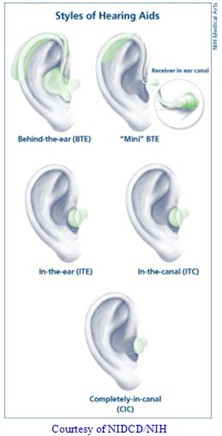The following short quiz below is based on the American Academy of Otolaryngology – Head & Neck Surgery’s revised five-minute hearing test.* Think about your daily experiences without hearing aids when thinking about the answers.
Quiz:
- Do you have trouble hearing over the telephone?
- Do you have trouble understanding two or more people talking at the same time?
- Do you have trouble understanding the television?
- Do you strain to hear conversations?
- Do you worry about missing the telephone or doorbell?
- Do you have trouble hearing in a noisy background or in a crowded room?
- Do you get confused as to where sounds come from?
- Do you misunderstand words and ask people to repeat themselves?
- Do you have trouble understanding women and children?
- Do you understand speakers in a large room such as a church service?
- Do you think people are mumbling around you?
- Do people seem frustrated that you misunderstood their words?
- Do you often make inappropriate responses when you don’t hear people clearly?
- Do you feel isolated at social activities due to not hearing clearly?
- Do you choose not to participate in activities due to feeling isolated?
According to the NIA-NIH, approximately one in three people between the ages of 65 and 74 has hearing loss, and nearly half of those older than older than 75 have difficulty hearing. Noise, aging, disease and heredity all contribute to loss of hearing. Although it’s a common problem, people have trouble admitting they need assistance with hearing loss. Admitting hearing loss is the first step to getting the help one needs.
Hearing Loss is Medical Issue
Damage to the inner ear can be caused by loud noises such as lawn mowers, snow blowers, or loud music. Loud noises can also contribute to tinnitus. There are things one can do to prevent more damage such as turning down the sound on the stereo, television or headphones, moving away from loud noise or using ear plugs or other protection.
Sounds from the eardrum to the inner ear can be blocked by earwax or fluid buildup. Your doctor can help with mild treatments to soften earwax buildup.
Damage to the eardrum can be caused by infection, pressure, or putting objects in the ear, including cotton swabs. If you have pain or fluid draining from the ear, see your doctor.
Diabetes or high blood pressure can contribute to hearing loss. Ear infections caused by viruses and bacteria can affect your hearing, as can heart conditions, strokes and brain injuries.
Certain medications play a roll in hearing loss. “Ototoxic” medications used to treat serious infections, cancer, and heart disease can damage the inner ear, sometimes permanently. Some antibiotics are ototoxic. Even aspirin is ototoxic at some dosages. Let your doctor know if you notice a problem while taking a medication.
Heredity can is a common cause of hearing loss, but not all inherited forms of hearing loss take place at birth. For example, in otosclerosis, which is thought to be a hereditary disease, an abnormal growth of bone prevents structures within the ear from working properly. It shows up later in life.
It’s important to address hearing loss as a medical issue because it can get worse if ignored or left untreated. Older people may become depressed, or withdraw from others when they feel frustrated or embarrassed about not understanding what is being said. Sometimes, older people are mistakenly thought to be confused, unresponsive, or uncooperative because they don’t hear well. There are remedies, such hearing aids, special training, certain medications and surgery that can help resolve these issues. See your doctor.
Connection Between Hearing and Cognitive Health
Recent studies show that older adults with hearing loss have a greater risk of developing dementia over those with normal hearing. Cognitive abilities (including memory and concentration) also decline faster in older adults with hearing loss. Treating hearing problems may be important for cognitive health. (More information on the Connection Between Hearing and Cognitive Health)
Hearing Aids
Most hearing aids share several similar electronic components designed to help people hear better.
- A microphone that picks up sound.
- Amplifier circuitry that makes the sound louder.
- A miniature loudspeaker (receiver) to deliver amplified sound into the ear canal.
- Batteries that power the electronic parts.
Hearing aids differ by design, technology and features. Some hearing aids have earmolds or earpieces to direct the flow of sound into the ear and enhance sound quality. Hearing aid selection is based on the type and severity of hearing loss, listening needs, and lifestyle.
Hearing Aid Styles
 “Behind-the-ear (BTE) aids have most parts contained in a small plastic case that rests behind the ear. The case is connected to an earmold or an earpiece by a piece of clear tubing. This style is often chosen for young children because it can accommodate various earmold types, which need to be replaced as a child grows. Also, BTE aids are easy to clean and handle, and are relatively sturdy.
“Behind-the-ear (BTE) aids have most parts contained in a small plastic case that rests behind the ear. The case is connected to an earmold or an earpiece by a piece of clear tubing. This style is often chosen for young children because it can accommodate various earmold types, which need to be replaced as a child grows. Also, BTE aids are easy to clean and handle, and are relatively sturdy.
“Mini” BTE, or receiver in canal (RIC) aids are a type of BTE aid that fits behind the ear, but is typically smaller in size. A narrow tube is used to connect the aid to the ear canal. Mini BTEs may have a smaller earpiece for insertion, but may also use a traditional earmold. These earpieces may reduce the occlusion effect in the ear canal—a plugged up sensation that causes a hearing aid user’s voice to sound louder inside the head—and increase comfort, reduce feedback, and address cosmetic concerns for many users.
In-the-ear (ITE) aids have all parts of the hearing aid contained in a shell that fills in the outer part of the ear. The ITE aids are larger than the in-the-canal and completely-in-the-canal aids, and may be easier to handle than smaller aids.
In-the-canal (ITC) aids and completely-in-the-canal (CIC) aids are tiny cases that fit partly or completely into the ear canal. They are the smallest hearing aids available and offer cosmetic and some listening advantages. However, their small size may make them difficult to handle and adjust.” (NIH)^
Analog and Digital
“Analog hearing aids are less common. They make continuous sound waves louder by amplifying all sounds (speech and noise) in the same way. Some analog hearing aids have a microchip to store multiple program settings used in different listening environments, such as in a quiet place (library) or in a noisy place (restaurant or soccer field). As the listening environment changes, the hearing aid settings may be changed by pushing a button on the hearing aid.
Digital hearing aids are more common. They have all the features of analog programmable aids, but they convert sound waves into digital signals and produce an exact duplication of sound. Microchips in digital hearing aids analyze speech and other environmental sounds and store multiple program settings. The digital hearing aids allow for more complex sound processing during the amplification process which may improve performance in certain situations, such as background noise and whistle reduction. They also have greater flexibility in hearing aid programming so the sound they transmit can be matched to the needs for a specific pattern of hearing loss.” (Mayo)
Hearing Aid Features
- “Directional microphone may help you speak in noisy environments. When the directional microphone is activated, sound in front of you (face-to-face conversation) is amplified to a greater level than sound from behind you.
- Noise Reduction reduces the levels of background noise compared to the sounds you are trying to hear.
- Feedback suppression helps prevent the hearing aid from producing an uncomfortable squealing sound.
- T-coil (Telephone switch) allows you to switch from the normal microphone setting to a T-coil setting to hear better on the telephone. All wired telephones must be hearing aid compatible. In the T-coil setting, environmental sounds are removed and sound is picked up from the telephone. This also turns off the microphone on your hearing aid so you can talk without your hearing aid whistling.
The T-coil works well in theaters, auditoriums, houses of worship, and other places that have an induction loop or FM installation. A speaker’s voice, who may be far away, is amplified significantly more than any background noise. Some hearing aids have a combination M (microphone) and T (telephone) switch, so while listening with an induction loop, you can still hear nearby conversations.
- Wireless connectivity can allow a hearing aid to receive streamed audio (e.g., music, phone calls) and allow the user to adjust the hearing aid settings.
- Direct audio input allows you to plug in a remote microphone or an FM assistive listening system, connect directly to a television, or connect to other devices such as your computer or radio.
The more complicated features may allow the hearing aids to best meet your particular pattern of hearing loss and may improve performance in specific listening situations. However, these sophisticated electronics may increase the cost of the hearing aid.” (Cleveland Clinic)
Hearing Aids Can Improve Quality of Life
Sometimes hearing loss comes on so gradually that it becomes habit. If you see your loved ones struggling with any of the above “signs of hearing loss,” it’s time to have a discussion and consult a doctor. Hearing loss can hurt your quality of life, both as a patient and as a caregiver. Communication is a huge part of life. Studies show you can improve your self-esteem, physical health, and almost every other aspect of your life with the use of hearing aids.
Many advantage plans and private insurance are now offering help with the purchase of hearing aids. Even a limited amount of financial assistance is bringing much needed relief to those who previously felt hearing aids were out of range of the budget. Combined with current technological advances, which bring the cost of hearing aids within reason, many seniors can now reach a goal of better hearing.
Find more information about better hearing.
*Source: Koike, J.; Hurst, M.K.; and Wetmore, S. J. Correlation between the American Academy of Otolaryngology -Head and Neck Surgery five-minute hearing test and standard audiological data, Otolaryngology – Head-Neck Survey, Volume 111 (5), pp. 625-632.
*Source: NIH – Types of hearing aids
*Source: Web MD Which One Suits You











